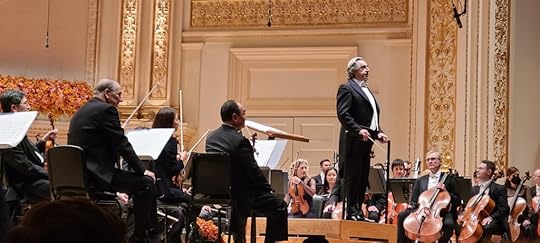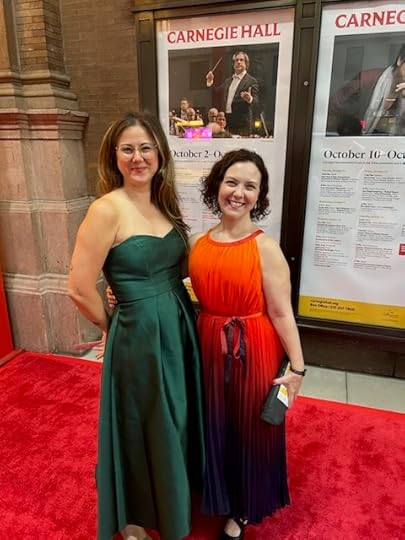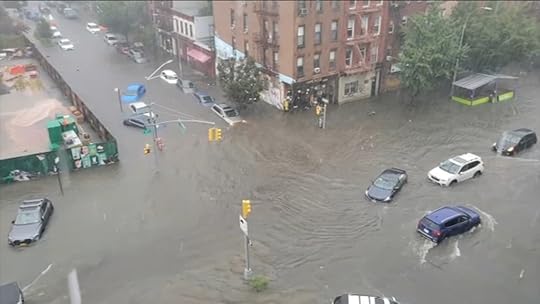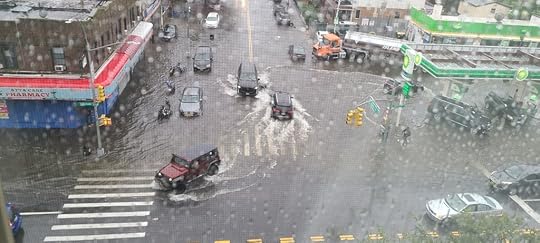Christa Avampato's Blog, page 23
October 14, 2023
Climate communicators must become storymakers, not just storytellers
 Photo by Camellia Yang on Unsplash
Photo by Camellia Yang on UnsplashThis piece by World Economic Forum posted by UN Biodiversity gets it right when it comes to climate communications. It starts with the important grim facts of biodiversity loss — human activity is destroying biodiversity faster than in the last 10 million years, over 1 million species face extinction, 80% of threatened species are impacted by our activity, and we’ve degraded 40% of the land. Then it pivots to 5 solutions that improve our lives, save nature, create 117 million jobs, and generate $3.015 trillion dollars by 2030:
1)Higher-density urban development to free up land for agriculture and nature — $665 billion; 3 million jobs
2)Architecture with nature, not just humans, at the core of the design to benefit us and other species — $935 billion; 38 million jobs
3)Utilities that effectively manage air, water, and solid waste pollution in cities — $670 billion; 42 million jobs
4)Nature-based solutions for infrastructure like wetlands, forests, and floodplains to manage the impacts of rain, wind, and storms — $160 billion; 4 million jobs
5)Incorporating nature such as wildlife corridors into infrastructure — $585 billion; 29 million jobs
Total: $3.105 trillion; 117 million jobs
Tell me another set of policies that produces that much revenue and that many jobs. There isn’t one. Line up the investors for this unicorn deal. Which politicians are turning down this set of policies with these societal benefits? Those who won’t be elected. This is the power of effective climate storytelling about solutions and their benefits. These are stories that change the world. Tell them. Make them.
As climate communicators, we can’t drop audiences off at the abyss and leave them there. We can’t just be storytellers; we must be storymakers and solutioneers if we want to be part of the web of humanity that weaves a healthier, more joyful, peaceful, and sustainable world into existence. This is a lot to ask of my inspiring and beloved climate communications colleagues who are already doing so much. But I’m asking us to do more because the world needs us now more than ever.
You wanted to be a writer, journalist, filmmaker, or video game creator. You hadn’t planned on becoming a product developer, systems designer, policy maker, and community organizer. That wasn’t the deal. I know. The deal changed. The world changed. We have to change.
There’s a Hopi proverb that says, “Those who tell the stories rule the world.” As the CEO of Pixar Animation Studios, Steve Jobs said “The most powerful person in the world is the storyteller. They set the vision, values, and agenda of an entire generation.”
This is the mantle we have to take up. We have to tell stories about solutions that clearly communicate their benefits. Then we lead our audiences into the trenches to collectively roll up our sleeves and get the work done using the empathy and compassion in our hands, hearts, minds, and spirits to build a better world for all beings.
October 13, 2023
Using design thinking to solve any challenge
 Photo by UX Indonesia on Unsplash
Photo by UX Indonesia on UnsplashDesign thinking is an incredible mindset and tool kit whether you’re trying to solve world peace, save the planet, construct a curriculum or framework, create a product, service, or system, or build and iterate on something to solve a common everyday problem. I’d love to do a session with you to show you how it works if you’ve never used it before.
Yesterday it was a joy to start to introduce design thinking to a colleague of mine. Seeing his eyes light up and the wheels of his mind turn made me a little jealous of him. I remember that exact feeling of being overwhelmed by entering a whole new world when Bob Giampietro, my boss at the time at Toys R Us, got me hooked on IDEO’s then-nascent design thinking philosophy.
Since then, I’ve used IDEO’s work constantly in my product development and design work. No matter what the challenge is, no matter the industry, and no matter the form factor of the outcome, I’ve found design thinking works. It’s especially good for complex collaborative projects when so many other methods fall short.
If you’re interested in learning more, please drop me a note at christa.avampato@gmail.com. I’d love to help you solve problems and make the world a better place for all beings.
October 12, 2023
Walking the path of peace
 Photo by Levi Meir Clancy on Unsplash
Photo by Levi Meir Clancy on UnsplashEven though I’m not Jewish, I’ve spent the majority of my adult life in Jewish communities. Penn, where I went to undergrad, was 35% Jewish at the time. I attended my first Shabbat dinners there and learned about Jewish culture, traditions, and holidays.
New York theater, where I started my career, has a large Jewish community. I lived on the Upper West Side for many years, a neighborhood that is largely Jewish. Now I live in Ditmas Park, Brooklyn where there is a mix of just about every religion, culture, and language, including a large Jewish community and a large Muslim community who live side-by-side. Many of my dearest friends are Jewish and Muslim, and their pain now is palpable.
My friends Vince and Jane visited me last weekend. When we went out for our kosher pizza crawl and tasting, we found that nearly every shop was closed, in mourning. As I’ve gone for my run each day this week, I can see and feel the heavy weight of sadness here. Everyone is waiting for word about their loved ones and what will happen next in this horrible, dangerous war.
I have been in touch with my friends in Israel, and friends here whom I know have family there. Thankfully, they are all safe. And all of them are scared. Some are leaving the country. Some are determined to stay. Some are still trying to decide what to do. The heightened alert has also extended to NYC.
The footage from Israel and Gaza is difficult to watch this week but I have forced myself to do it to bear witness and to listen to their stories. I find myself crying with them, hurting with them, and fearing what’s to come.
I’m not an expert on the geopolitics there, nor on all of the history. But I do know that people whom mean a lot to me are there, and I’m afraid for their safety every day. I’m gutted for all of the families and friends who have lost someone and who have no idea where their loved ones are. I’m devastated for all of the children, the wounded, those whom we’ve lost, and the many who have lost who and what they hold dear.
I’m hoping for peace for everyone. Israel and Gaza have already been through so much, especially this last year. Now the devastation has escalated exponentially.
Yesterday, I found this photo by Levi Meir Clancy. It was taken last year at Netiv HaAsara facing the Gaza border. It has the words “Path to Peace” in Hebrew, Arabic, and English further along and the mural depicts a path with flowers, homes, and trees. Netiv HaAsara is a moshav (a cooperative agricultural community) in southern Israel. I hope we can all find our way to that path and walk together. There is so much healing needed.
Looking to Tom Friedman for guidance in Israel
 Photo by Cole Keister on Unsplash
Photo by Cole Keister on UnsplashThere are a few writers whom I count as my North Stars and Tom Friedman is at the top of the list. He has deeply immersed himself, physically and intellectually, in global geopolitics for more years than I’ve been alive. After the Hamas attacks in Israel, he contacted his North Stars in the region, Nahum Barnea, a veteran Yediot newspaper columnist, and Professor Victor Friedman (no relation), who teaches behavioral science at Jezreel Valley College in central Israel.
He wrote about his thoughts and theirs in his New York Times column on October 7th with a piece titled Israel’s Worst Day at War. He followed up that piece with another on October 10th titled Israel Has Never Needed to Be Smarter Than in This Moment.
These two unlocked links are well worth reading and contemplating. He addresses the heavy weight of history, Netanyahu’s divisive politics, and what the U.S., Israel, and countries like Saudi Arabia must do now to prevent the whole of human society from being thrown into violent chaos.
I hope Friedman has a direct line to the offices of Biden, Netanyahu, Israel’s opposition leader Benny Gantz, and MBS. His knowledge, perspective, and counsel is crucial right now as the world holds its breath.
We will see if the unity government in Israel is a real shift in Netanyahu’s psyche and not just a symbolic gesture. War can create otherwise unlikely allies. Time will tell in short-order whether we collectively descend into darkness or rise into the light. I continue to root for our better angels, and for peace.
October 11, 2023
The book Storyworthy by Matthew Dicks is a masterpiece about storytelling
 https://matthewdicks.com/storyworthy/
https://matthewdicks.com/storyworthy/The book Storyworthy: Engage, Teach, Persuade, and Change Your Life through the Power of Storytelling by Matthew Dicks is to storytelling what The Elements of Style by Strunk & White is to writing. Reading it immediately improves our craft because the advice is approachable and applicable. For every audience about any topic in any medium, every page of Storyworthy shows us how and why to tell stories, including the behind-the-scenes processes that make stories memorable and vehicles that can change hearts, minds, and behaviors.
When I first picked up Storyworthy, I didn’t expect much. I’ve read dozens of books on storytelling and many of them offer similar advice. When one of my best friends recommended Storyworthy, I was skeptical. However, my friend is a law professor who teaches writing and argument construction, and she is an exceptional storyteller whom I’ve worked with on storytelling shows. With her recommendation, I figured I could spend a few minutes flipping through it. My dissertation at University of Cambridge is centered around storytelling so if nothing else, I figured maybe I’d pick up one or two pointers that might be useful.
By the time I got to page 2 of the preface, I was completely hooked even though Matt hadn’t yet given a scrap of advice on storytelling. His honesty is what got me. He opens the book with the first time he ever contemplated telling a story live on stage. He’s deeply conflicted about it. He has so much respect for the art form and he’s completely terrified of being judged. The stakes are high. His nervousness becomes my nervousness. I’ve felt that sick feeling in the pit of my stomach. I feel it every time I tell a story or do any kind of presentation in front of an audience. Terrified, he just goes for it. He takes his shot, and decides if his name gets picked he’ll just tell a story scared. He’s my kind of guy. I love risk-takers. I root for them.
The book unfolds chapter after chapter with advice, exercises, and samples of Matt’s stories. These aren’t platitudes like “people love an underdog” or “start at the end and work backwards” that I’ve read in other storytelling how-to books multiple times. Both of those ideas are generally true and helpful but Matt goes so much further than that kind of advice.
He explains exactly why and how he chooses his beginnings, endings, and the arc that connects them. He talks about pacing and timing, content and structure, word selection, story strategy, and storytelling devices to grab and hang onto an audience’s attention. Storyworthy is a playbook and it works for every story by every storyteller. It’s a compass, map, flashlight, and go-bag for everyone who has something to say that someone else needs to hear. It’s for all of us.
At one point, a friend of Matt’s whom I know and have told stories for, grabs his arm and tells him that he absolutely can’t tell anyone his secrets (or hers!) about how to create and tell a story. He laughs, ignores her, and thankfully we have Storyworthy. He’s given us the tools he has and uses every day.
This might sound counterintuitive. Shouldn’t he keep some of this to himself so he can continue to make money from workshops, consulting, writing, and shows? Shouldn’t he hold back just a little? He’s the real trick: by telling his secrets I can’t wait to take a class with him to show him how I’m using these tools and to get his feedback so I can level up even further.
Actually, I have to take a class with him. Here’s why: Matt is a lifelong learner. He wrote Storyworthy five years ago. I bet he’s got even more tools, tips, and advice to share now, especially after the pandemic. And I want to know all of them.
My dissertation about storytelling involves interviewing storytelling experts. I want to interview Matt. My friend who recommended Storyworthy to me said he probably won’t agree to an interview. He’s busy. A man-in-demand. I wrote him an email anyway. Even if he said no or never responded, at least he’d know how much his book means to me and how much it’s helped me become a better storyteller and a better human.
I’m a big believer in the idea that unexpressed gratitude is a horrible waste of a resource. Imagine what kind of world we’d have if people just said thank you more often.
So I go to Matt’s website. I navigate to his online contact form and put the advice in his book to work to craft my pitch. I was honest to the point of gushing about the book. All of it true. I gave some hints about my life. I told him about my dissertation’s research question and why it’s so important to me. I closed it by saying that this kind of request from someone he doesn’t know may feel a bit out of left field. It may not be of any interest to him, and if that’s the case that’s okay. Again I tell him that if all this message does is explain how much I appreciate the time and effort he took to write Storyworthy, then that’s what matters the most.
I click “submit form” and close my laptop. I take my dog outside for walk. I worry about my dissertation. I have to interview 30 — 40 experts. People are busy. What if they all say no? What if no one wants to talk to me? I better come up with a plan B just in case the worst happens. I should start that plan today because I have no idea how I’m going to explain this to Cambridge and keep my dignity.
I go back up to my apartment and open my email. A note from Matt. “Well this is the second fastest rejection I’ve ever gotten,” I think. The first was from a literary agent I queried a few years ago when I was shopping my first novel. The response from the agent came back less than a minute after I sent it, and it had just one word. “No.” I should dig it out from my email archive and send it into the Guinness World Records. Fastest rejection ever—what a record to hold.
I take a deep breath and open up Matt’s message. He says he appreciated my kind words about the book and he’s glad it helped me. Well, at least it’s a nice rejection, I think.
Then he writes if we can make the timing work, he’d be happy to be interviewed. Hand to heart, I danced around my apartment. We figured out a date in short order and it’s in the calendar. I’ve got a few months to prepare for this interview, and I can’t wait for everything I’ll learn during it. Saying thanks really is an under-rated way to build a connection.
October 10, 2023
Ditch rejection and be a magic maker
 Photo by Karly Santiago on Unsplash
Photo by Karly Santiago on UnsplashI have no fear of rejection in any area of my life. I’d much rather be rejected than regret not taking my shot. I’ve been rejected so often that when I get a positive response, it’s a genuine surprise and delight! If I admire someone’s work, I reach out to them and come to the table with humility as a partner and collaborator who wants to work toward a win-win solution and a shared vision.
Over the past few weeks I’ve been reaching out to people doing work I’m passionate about that’s related to my dissertation at University of Cambridge. I don’t know any of them, nor do we have any mutual connections. I’m just sending off blind emails explaining who I am, what I care about, and what I love about their work. I’ve yet to get a rejection – they’ve all said they’d be happy to talk to me and to see what we can create together.
So often we take ourselves out of the running because of a fear of rejection. Think of all the wasted potential that causes. The worst that will happen is they’ll say no, or not respond. Muster up the courage and put yourselves out there. Out there is where the magic happens, and right now our world needs more magic makers. Be one of them.
October 9, 2023
Bringing storytelling through video games into the climate change movement
 Photo by Rodion Kutsaiev on Unsplash
Photo by Rodion Kutsaiev on UnsplashDuring my Masters program at University of Cambridge, I’ve been researching how video games can inspire and foster climate action. Today I had the chance to play the vertical slice (the beginning prototype) for the game that I’ve been working on. It’s beautiful, emotional, and challenging — all characteristics of a game that connect with players, and connect those players to something far beyond their screens.
3 billion people across the globe play video games. However, storytelling through video games has largely been absent from the climate change conversations that involve policy makers, governments, businesses, climate scientists, academics, and climate communicators. As someone who belongs to all of those communities and has worked in all of those sectors, I hope that I can be a bridge that not only brings them together but also helps them to collaborate and work together toward their common goal for a healthy, sustainable planet for all.
This game could be a game changer, and I can’t wait to see where this goes. More details soon as the prototype grows toward the market launch in Fall 2024.
October 5, 2023
Roll out the red carpet: Carnegie Hall opens the 2023–2024 season
 Riccardo Muti with the Chicago Symphony Orchestra on opening night 10/4/23. Photo by Christa Avampato.
Riccardo Muti with the Chicago Symphony Orchestra on opening night 10/4/23. Photo by Christa Avampato.Last night I went to Carnegie Hall’s opening night gala with one of my best friends and my many talented colleagues. It was thrilling to hear the Chicago Symphony Orchestra under the expert baton of Riccardo Muti with the incomparable violin soloist Leonidas Kavakos, and to experience this gorgeous music with a packed house of nearly 3,000 people in this historic venue. The program included Tchaikovsky’s Violin Concerto in D Major, Op. 35 and Mussorgsky’s Pictures from an Exhibition orchestrated by Ravel. As an encore, Muti chose the brief and beautiful aria Amor ti vieta (Love forbids you) that appears in Intermezzo from Fedora by Giordano and Colautti.


Happy to be at Carnegie Hall’s opening night. Photos by Christa Avampato.
A performance at Carnegie Hall is a must-do for New Yorkers and visitors. This year’s season features Yo-Yo Ma and John Williams, Mitsuko Uchida, The Vienna Philharmonic, Jason Moran, The Hot Sardines with Alan Cumming, Lea Michele, Sutton Foster, Kelli O’Hara, Sheku Kanneh-Mason, Norm Lewis, Bryan Terrel Clark and Valisia LaKae with The New York Pops, Meow Meow, Patti Lupone, Emanuel Ax, Yuja Wang, Yannick Nézet-Séguin and The Met Orchestra, Tania León, and many, many more.
At 132 years old, Carnegie Hall is a stunning space in midtown Manhattan and the heart of its mission is to bring the transformative power of music to the widest possible audience. It’s a privilege to work with them and contribute to this organization’s legacy in my extraordinary city.
 The Chicago Symphony Orchestra warms up for opening night. Photo by Christa Avampato.
The Chicago Symphony Orchestra warms up for opening night. Photo by Christa Avampato.One of my main projects at Carnegie is the subscription streaming channel Carnegie Hall+. We curate concerts, music festivals, dance, opera, and music documentaries from around the globe and deliver them to music lovers in the U.S. and 20 other countries. We have a lot of exciting developments underway for the year ahead. If you’d like to learn more, I’m always happy to chat about it. You can also find more details here: https://www.carnegiehallplus.com/
Happy opening, Carnegie Hall. I look forward to making more music available to more people in more places this season.
October 1, 2023
It’s time for a public-private funded climate WPA and PWA in NYC
 Screenshot of Brooklyn floods on September 29, 2023 captured by ABC 7 NY
Screenshot of Brooklyn floods on September 29, 2023 captured by ABC 7 NY“If I don’t work, I don’t eat so I have to be out here, even when there’s a flood.” This was a quote from a NYC delivery worker on the news during the September 29th, 2023 flash floods. His electric bike failed in the knee-deep water. He was pushing it against the current to deliver food.
NYC now has the largest income gap of any large city in the country — the top 20% make 53 times more than the bottom 20%. We’re failing our people with no social safety net, no protection from climate hardship, and few pathways out of their circumstances. City workers often live in temporary shelter and public housing because they don’t earn enough to make rent but residency is often required for their jobs.
This city is run by service workers. They are the lifeblood that keeps the city moving. Failing them will cause the city to crumble.
We also have the migrant crisis. Right now at the U.S.-Mexico border, the city is distributing these fliers:
 Flyer being handed out at the U.S.-Mexico border
Flyer being handed out at the U.S.-Mexico borderI cried reading it. This has been the city of dreams for decades. Now it is the city of dreams only for those who are already of means. That cannot continue.
New York is a city of immigrants. It always has been. They enrich and enliven the social and economic fabric on which this city’s creativity thrives. Without them, we lose who we are and what we stand for.
The economics and business side of my brain spends the bulk of my waking hours thinking about how to support New Yorkers, present and future. How do we boost the economy and provide opportunity to everyone who wants to be a New Yorker? How do we rebuild this city, not just for the privileged few but for all the huddled masses yearning to be free so that everyone wins together?
The historian and storyteller side of my brain always sifts the sands of the past to see what I can find and use. As the late great John Lewis, who was at one time a New Yorker and is one of my greatest inspirations, often said, “We must make a way out of no way.”
We have an immense amount of capital—NYC is the wealthiest city in the world with 340,000 millionaires. We also have staggering gaps in our economy that need attention: 24,000 city jobs vacancies, 20% office space vacancies, and city infrastructure that desperately needs repairs, particularly to prepare for climate impacts. We have people who want to work and make a difference but are being left behind—5.3% unemployment, 11.5% underemployment, 17% youth unemployment, 90,000 migrants and asylum-seekers over the last 18 months, and over 100,000 people without housing.
Now imagine this: New Yorkers of means collaborate hand-in-hand with policy makers and city agencies to put all of this wasted human capital to good use to rebuild this city through a Works Progress Administration / Public Works Administration that focuses on nature-based solutions. Good jobs. Good work. A way out of no way. They fortify our 520 miles of coastline with reefs, mangroves, and natural defenses, clean up, restore, and regenerate the 10,000 vacant lots for productive use like bioswales that reduce floods and the pressure placed on the water, sewer, and transporation systems, install green roofs and rooftop gardens, and build and connect wildlife corridors and habitats.
That’s just a start of how NYC can work with nature so that everyone is cared for. There are dozens of other solutions that are relatively low-cost, efficient, and proven to clean the air, water, and land—benefits that benefit every resident, visitor, and commuter.
This doesn’t have to be a concrete jungle. It can be a green, verdant, healthy, thriving place for all beings who want to be New Yorkers. It’s going to take a massive mobilization, and the relentless pursuit to match needs with resources to transform our challenges into opportunities. We have to do this work, and we have to do it now while we still have time. I’m tired of a dirty, flooded, and unequal New York. Aren’t you? I love this city. I love New Yorkers. And I want us to do better. We have to do better, and we can—together.
September 30, 2023
A river flows in Brooklyn
 South Brooklyn during Friday’s floods. Photo by Christa Avampato.
South Brooklyn during Friday’s floods. Photo by Christa Avampato.A river flowed from Prospect Park through my neighborhood in South Slope, Brooklyn on Friday when we were pummeled with 7+ inches of rain in ~12 hours. I didn’t realize NYC’s floods were international news until I started getting messages from friends outside the country. With over 13 inches of rain in September, this is the 2nd wettest September since NYC began keeping weather records in 1920.
I took this photo of the flooding from my apartment at 8am. As I watched the water gushing through the streets, I thought about a conversation I had with my friend, Alex MacLennan, almost a decade ago. He told me the climate models then predicted the western half of the US would grow increasingly drier and hotter while the eastern half would be regularly flooded. How right they were.
NYC is an archipelago that sits mostly at sea-level surrounded by brackish water with the busiest shipping port in the US. Though it looms large on the national and international stages as a financial, cultural, political, and media capital, area-wise it’s small and easily overwhelmed by water.
It is, in many ways, a climate disaster waiting to happen. It’s the mostly densely populated city in the U.S. with nearly 28,000 people per square mile and has the largest population with almost 9 million people, more than double the size of the next largest city. The population doubles during the workday with as many commuters as residents. It’s also a city of hard surfaces (though we have 7 million trees and the tree canopy covers 21% of the city). Aged infrastructure and a subterranean subway that is 100+ years old further compound threats from flash flooding, coastal storms, and sea level rise. Flooding here is a crisis that must be urgently and unrelentingly addressed.
The country and world can’t afford to lose New York. While some strides have been made to protect the city from climate change, it’s not nearly enough. But all that may be changing, and fast.
There are plans underway to transform Governor’s Island in New York Harbor into the largest climate research and entrepreneurial center in the world. We desperately need this. The scale and impact of this project on our city, the country, and the world will be significant. It has to be significant because the climate crisis deepens every day.
These floods will become more frequent and intense in the coming years. We have to mitigate and adapt at the same time with nature-based solutions like biophilic architecture, mangroves, reefs, rooftop farms, and the transformation of vacant lots into bioswales. They are proven, efficient, and relatively inexpensive solutions. I hope the work at Governor’s Island can make these ideas realities.
Like all investments, nature-based solutions take time to create and scale. We have no more time to waste. We have to get started now, and it’s my hope that I can do my part to push this work forward.



